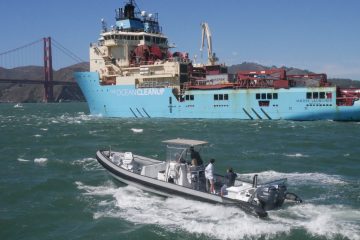The World’s First Unmanned Oceanic Garbage Collection System Gets a Bay Area Send Off
Our ship, The Harbor Emperor, had just passed the “Welcome Home” mural on the end of Pier 31 when we got our first glimpse of it. In the distance, there was the San Francisco fire boat perfectly hidden by the great spouts of water it was sending off, and beyond that, past the Bay Bridge, the Maersk Launcher began to emerge from the sunny haze.
This was the boat that would tow System 001, the world’s first passive garbage collection system developed by the Dutch non-profit The Ocean Cleanup. Once deployed, System 001 will drift through the Great Pacific Garbage Patch corralling harmful plastics and other detritus for easy pick up by garbage ship.

Maersk Launcher, the boat towing The Ocean Cleanup’s System 001 makes it’s way past the Bay Bridge. September 8, 2018. Photo by Lisa Martin
System 001 is the brainchild of Boyan Slat, founder and CEO of The Ocean Cleanup. In 2012, Slat’s TED Talk outlining his idea for using ocean currents to collect plastic flotsam went viral, allowing the then-teenaged Slat to crowd fund and attract investors for the project and build up a staff of experienced maritime specialists and scientists.
The mission of The Ocean Cleanup is to develop “advanced technologies to rid the world’s oceans of plastic.” They believe that they can clean up half of the Great Pacific Garbage Patch using a fleet of these drifting systems, of which System 001 is (you guessed it) the first.
The Great Pacific Garbage patch, a huge circulating system of currents (known as a “gyre”) located between Hawaii and California, has been collecting garbage for years and is now the largest patch of plastics in the Ocean. It is 3 times the size of France and The Ocean Cleanup estimates there is approximately 80,000 tons of plastic in the Great Pacific Garbage Patch.
While the Great Pacific Garbage Patch is the biggest, there are four additional gyres of significant size around the world.
If System 001 works in the open ocean, then this could be a means of removing plastic that’s already in the ocean instead of just trying to prevent it from reaching the ocean. If System 001 works, this will mark the beginning of The Ocean Cleanup’s venture to deploy more of these systems to the Great Pacific Garbage Patch as well as to the other gyres.
There’s a lot riding on System 001, which looked kind of like a very long black pool noodle, as the Maersk Launcher towed it slowly past the wharves.

The Maersk Launcher moves slowly past San Francisco as it tow’s The Ocean Cleanup’s System 001 out to sea. September 8, 2018. Photo by Lisa Martin
System 001 is a 2000 foot long floating barrier with a skirt that extends ten feet below the water. The tube is designed to form a U-shape when it’s in the open ocean that funnels garbage to its center as it is moved by wind, waves, and currents.
And this video from The Ocean Cleanup will explain it way better than I ever will.
The plan is to take this noodle out 240 nautical miles into the Ocean where it will be tested for two weeks. The crew will use this time to test System 001’s functionality. Will it form the U-shape it needs to corral drifting garbage? Will it move as modeled? Slat said they planned to test System 001’s garbage collection data with GPS trackers that can be thrown in the water to gather data and later retrieved.
Barring major issues during this trial phase, the crew of the Maersk Launcher will move System 001 to the Great Pacific Garbage Patch sometime in October.
For Slat, he will know the system has proven itself when that “first shipload of plastic comes into the port.”
In the meantime he’s most worried about unanticipated conditions. System 001 is the culmination of five years of hard work . The Ocean Cleanup has built 6 prototypes and done hundreds of model tests, but even with that kind of preparation there can be unknowns. “Models are representations of reality. They are not reality.” Slat said.

Boaters move in to take a look at the Maersk Launcher before it heads past the Golden Gate Bridge. September 8, 2018. Photo by Lisa Martin
The Harbor Empress was chartered by the Ocean Clean Up to give members of the press a chance to film and shoot system 001 as it made its way out to the Golden Gate Bridge, pose questions to COO Lonneke Holierhoek and Technology Manager Arjen Tjallema, and to surround Boyan Slat in increasingly tight and ever so-slightly swaying circles of cameras and recording equipment.
We, however, were not the only ones on the water out to give System 001 it’s great Bay Area send off. Throughout the bridge-to-bridge journey, boaters motored and sailed past the slow-moving ship and it’s very long and potentially world-changing tow.
As the Maersk Launcher approached the Golden Gate Bridge, we got our first real glimpse of the crew on board. About ten people stood on the upper most deck waving their arms and cheering as they passed under the bridge on their way to proving grounds (proving waters?) of the Pacific Ocean.











